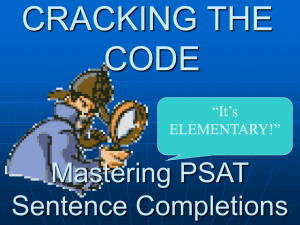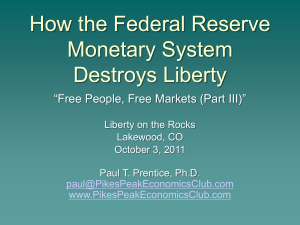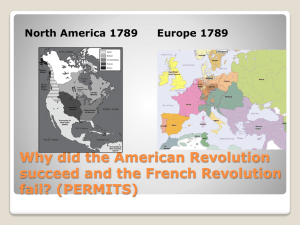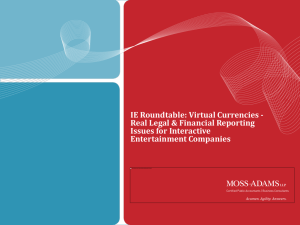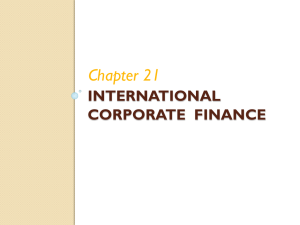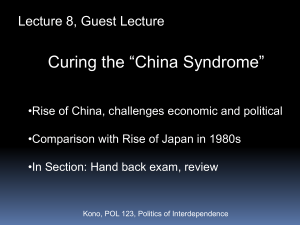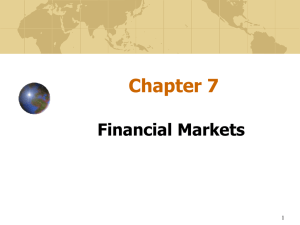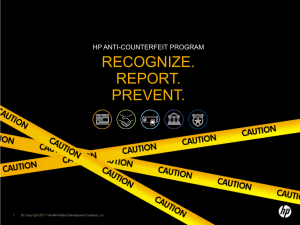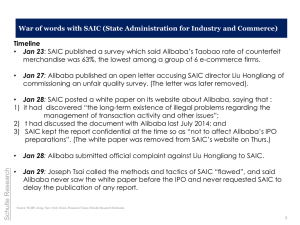ten dollars - Monterey County
advertisement
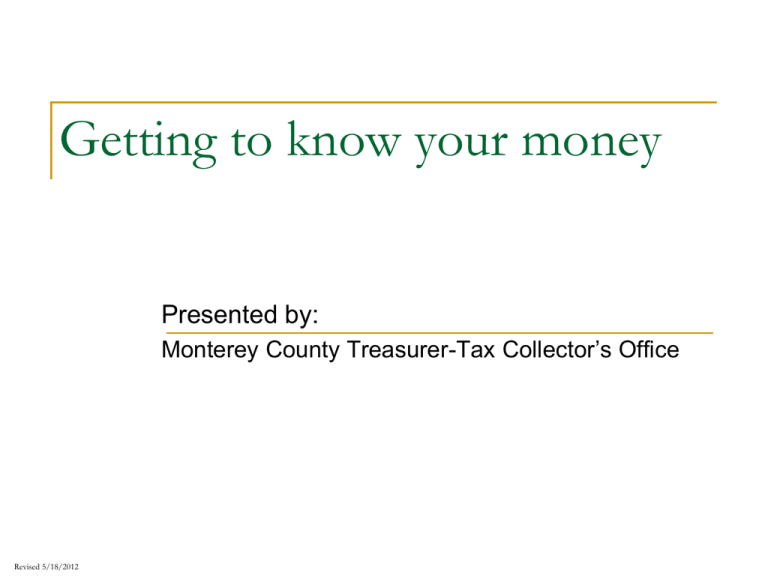
Getting to know your money Presented by: Monterey County Treasurer-Tax Collector’s Office Revised 5/18/2012 Do your part… As regular handlers of currency, you are the first line of defense against counterfeiters. The public is counting on you, and you need to be knowledgeable about the security features of the notes you handle. The Five Dollar Note Portrait of Abraham Lincoln Lincoln Memorial building http://www.newmoney.gov/currency/images.htm Security Features http://www.newmoney.gov/currency/5.htm Additional Features Low Vision Feature The Numeral 5 has been printed in high-contrast purple ink to help those with vision impairments to distinguish the denomination. http://www.newmoney.gov/currency/5.htm Additional Features Microprinting The $5 note contains microprinting in three areas: the words FIVE DOLLARS are found inside the left and right borders, the words E PLURIBUS UNUM appear at the top of the shield within the Great Seal; and the word USA FIVE appear along one edge of the large 5 low-vision feature. http://www.newmoney.gov/currency/5.htm The Ten Dollar Note Portrait of Alexander Hamilton U.S. Treasury Building http://www.newmoney.gov/currency/images.htm Security Features Color Shifting Ink Watermark By tilting the bill, the numeral 10 changes color from copper to green. Hold the bill to light and you’ll see a faint image of Hamilton. Security Thread Hold bill to light and you’ll see a thread embedded in the paper which reads USA TEN and a small flag. This thread glows orange under UV light. http://www.newmoney.gov/currency/10.htm Additional Features Low Vision Feature The Numeral 10 has been enlarged to help those with vision impairments to distinguish the denomination. http://www.newmoney.gov/currency/10.htm Additional Features Microprinting The Ten dollar note contains microprinting in three areas: the word USA and numeral 10 are found beneath the large torch, the words THE UNITED STATES OF AMERICA and TEN DOLLARS are located below the portrait as well as vertically inside the left and right borders. http://www.newmoney.gov/currency/10.htm The Twenty Dollar Note Portrait of Andrew Jackson White House http://www.newmoney.gov/currency/images.htm Security Features Color Shifting Ink Watermark By tilting the bill, the numeral 20 changes color from copper to green. Hold the bill to light and you’ll see a faint image of Andrew Jackson. Security Thread Hold bill to light and you’ll see a thread embedded in the paper which reads USA TWENTY and a small flag. This thread glows green under UV light. http://www.newmoney.gov/currency/20.htm Additional Features Low Vision Feature The Numeral 20 has been enlarged to help those with vision impairments to distinguish the denomination. http://www.newmoney.gov/currency/20.htm Additional Features Microprinting The Twenty dollar note contains microprinting in two areas: to the right of the portrait, the first three letters of the TWENTY USA ribbon has the inscription USA20 printed in blue. THE UNITED STATES OF AMERICA 20 USA 20 appears in black on the border below the Treasurer’s signature. http://www.newmoney.gov/currency/20.htm The Fifty Dollar Note Portrait of Ulysses S. Grant U.S. Capitol http://www.newmoney.gov/currency/images.htm Security Features Color Shifting Ink Watermark By tilting the bill, the numeral 50 changes color from copper to green. Hold the bill to light and you’ll see a faint image of Ulysses S. Grant. Security Thread Hold bill to light and you’ll see a thread embedded in the paper which reads USA 50 and a small flag. This thread glows yellow under UV light. http://www.newmoney.gov/currency/50.htm Additional Features Low Vision Feature The Numeral 50 has been enlarged to help those with vision impairments to distinguish the denomination. http://www.newmoney.gov/currency/50.htm Additional Features Microprinting The Fifty dollar note contains microprinting in three areas: the words FIFTY, USA, and the numerical 50 are imprinted in two of the blue stars to the left of the portrait, the word FIFTY can be found repeated within both sides of the borders of the bill, and the words THE UNITED STATES OF AMERICA appear on the collar of the portrait. http://www.newmoney.gov/currency/50.htm The Hundred Dollar Note Portrait of Benjamin Franklin Independence Hall http://www.newmoney.gov/currency/images.htm Security Features Color Shifting Ink Bell in Inkwell By tilting the bill, the numeral 100 changes color from copper to green. Look for bell inside copper colored inkwell, tilt the note and see the bell change color from copper to green. Watermark Hold the bill to light and you’ll see a faint image of Benjamin Franklin. http://www.newmoney.gov/currency/100.htm Additional Features 3-D Security Ribbon Look for blue ribbon to the right of the portrait. Tilt the note back and forth, you will see bells inside the ribbon change to 100s, if you tilt the note side to side they move up and down. http://www.newmoney.gov/currency/100.htm Additional Features Low Vision Feature Look for a large gold numeral 100 on the back of the note. It helps those with visual impairments to distinguish the note. http://www.newmoney.gov/currency/100.htm Additional Features Microprinting The Hundred dollar note contains microprinting in three areas: the words UNITED STATES OF AMERICA appear on Franklin’s jacket collar, the words USA are repeated throughout the borders, and the words ONE HUNDRED USA appear around the blank space where the watermark is located. http://www.newmoney.gov/currency/100.htm What to look for… Color shifting ink Watermark Security thread Other things to look for… Portrait The genuine portrait appears lifelike and stands out distinctly from the background. A counterfeit portrait is usually lifeless and flat. Details merge into the background which is often too dark or mottled. Genuine Portrait Counterfeit Portrait VS http://www.secretservice.gov/money_detect.shtml Other things to look for… Border The fine lines in the border of a genuine bill are clear and unbroken. On the counterfeit, the lines in the outer margin and scrollwork may be blurred and indistinct. Genuine Border Counterfeit Border VS http://www.secretservice.gov/money_detect.shtml Other things to look for… Serial Numbers Genuine serial numbers have a distinctive style and are evenly spaced. The serial numbers are printed in the same ink color as the Treasury Seal. On a counterfeit, the serial numbers may differ in color or shade of ink from the Treasury Seal. The numbers may not be uniformly spaced or aligned. Genuine SN Counterfeit SN VS http://www.secretservice.gov/money_detect.shtml Other things to look for… Paper Genuine currency paper has tiny red and blue fibers embedded throughout. Often counterfeiters try to simulate these fibers by printing tiny red and blue lines on their paper. Close inspection reveals, however, that on the counterfeit note the lines are printed on the surface, not embedded in the paper. Genuine Paper Counterfeit Paper VS http://www.secretservice.gov/money_detect.shtml Other things to look for… Federal Reserve and Treasury Seals On a genuine bill, the saw-tooth points of the Federal Reserve and Treasury seals are clear, distinct, and sharp. The counterfeit seals may have uneven, blunt, or broken saw-tooth points. Genuine Seal Counterfeit Seal VS http://www.secretservice.gov/money_detect.shtml Counter Detector Pens They contain an Iodine solution which reacts with the starch in wood-based paper to create a black stain. When used on fiber-based paper (used in real money) no discoloration occurs. It only detects bills printed on normal copier paper instead of fine papers used by the U.S. Treasury. Do not rely solely on counter detector pens! Ultraviolet lights They reveal UV-sensitive markings on 1996 or newer U.S. Currency $5 or greater. What if… What if I receive a counterfeit note? Do not return it to the passer. Delay the passer if possible. Observe the passer's description, as well as that of any companions, and the license plate numbers of any vehicles used. Contact your local police department or United States Secret Service field office. These numbers can be found on the inside front page of your local telephone directory. Write your initials and the date in the white border areas of the suspect note. Limit the handling of the note. Carefully place it in a protective covering, such as an envelope. Surrender the note or coin only to a properly identified police officer or a U.S. Secret Service special agent. Counterfeit Note Report (self-executable form) http://www.secretservice.gov/money_receive.shtml What if… What if I suspect a counterfeit, but I’m unsure? If you’re unsure of the authenticity of a note, contact your local police department or local Secret Service office in San Jose, CA at (408) 5355288. You may also contact the Monterey County Treasurer-Tax Collector with questions regarding currency security features. What if… What if I unknowingly accept a counterfeit note? If someone in your department unknowingly receives a counterfeit note, limit the handling of the note and place it in a protective covering when sending it to the County Treasury. Once received, we will send it to the U.S. Secret Service. Your department will not be reimbursed for the value of the counterfeit note. What if… What if I unknowingly include a counterfeit note with my department’s deposit? In most cases, the Monterey County Treasury will detect all counterfeit currency circulating through its office. If a counterfeit is found in your deposit, the Treasury will notify your department and the note will be sent to the United States Secret Service. Your department will not be reimbursed for the note. Remember, it’s the Law… Manufacturing counterfeit U.S. currency or altering it is punishable by a fine and/or imprisonment for up to 15 years. Possession of a counterfeit note with fraudulent intent is punishable by a fine and/or imprisonment for up to 15 years. For more information… If you need additional information visit http://www.secretservice.gov/know_your_money.shtml http://www.newmoney.gov/currency/default.htm Or Contact: Monterey County Treasurer-Tax Collector’s Office (831) 755-5015


